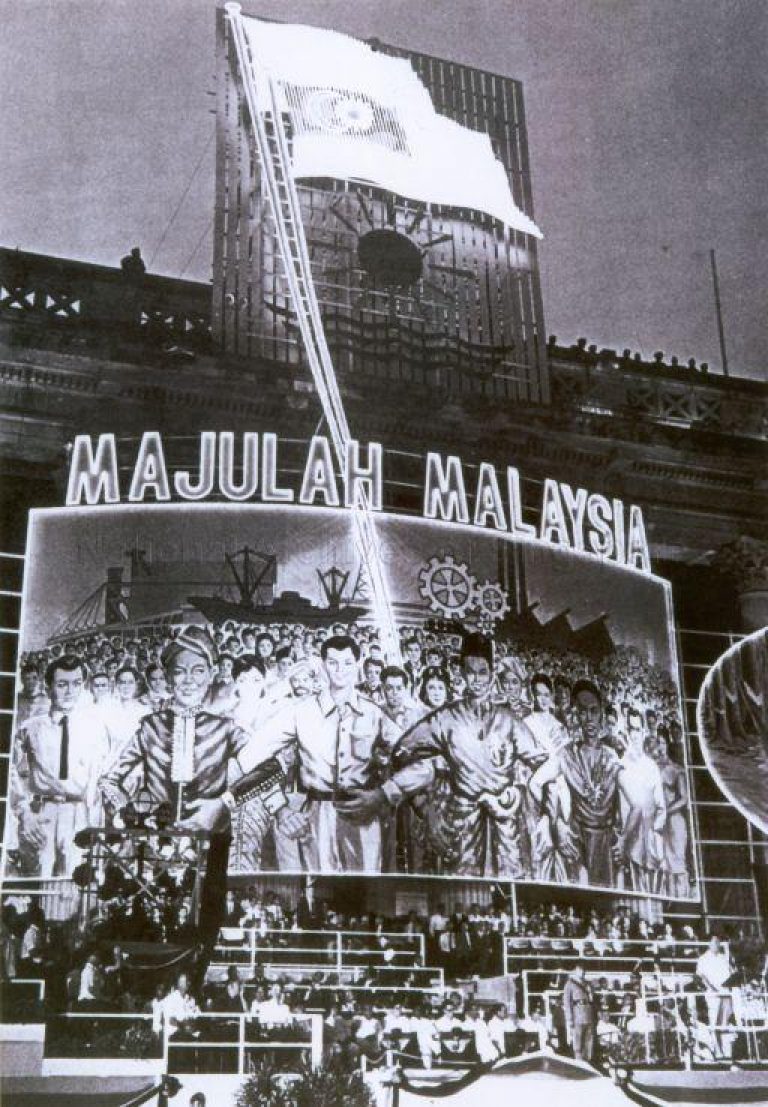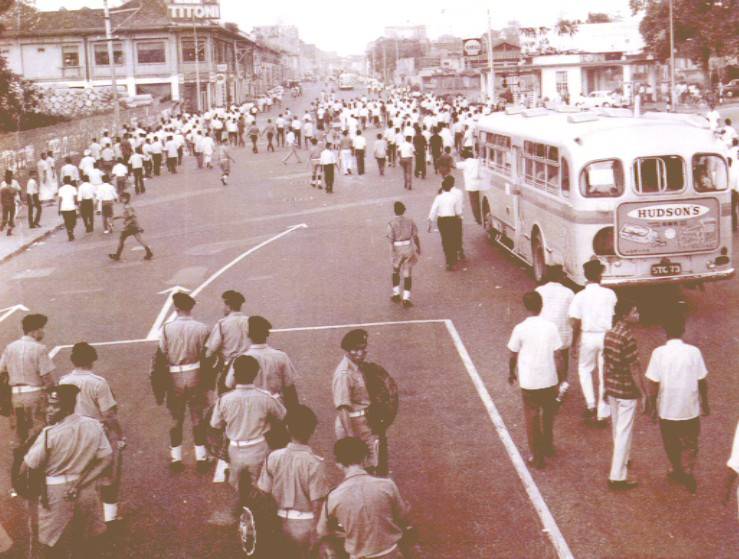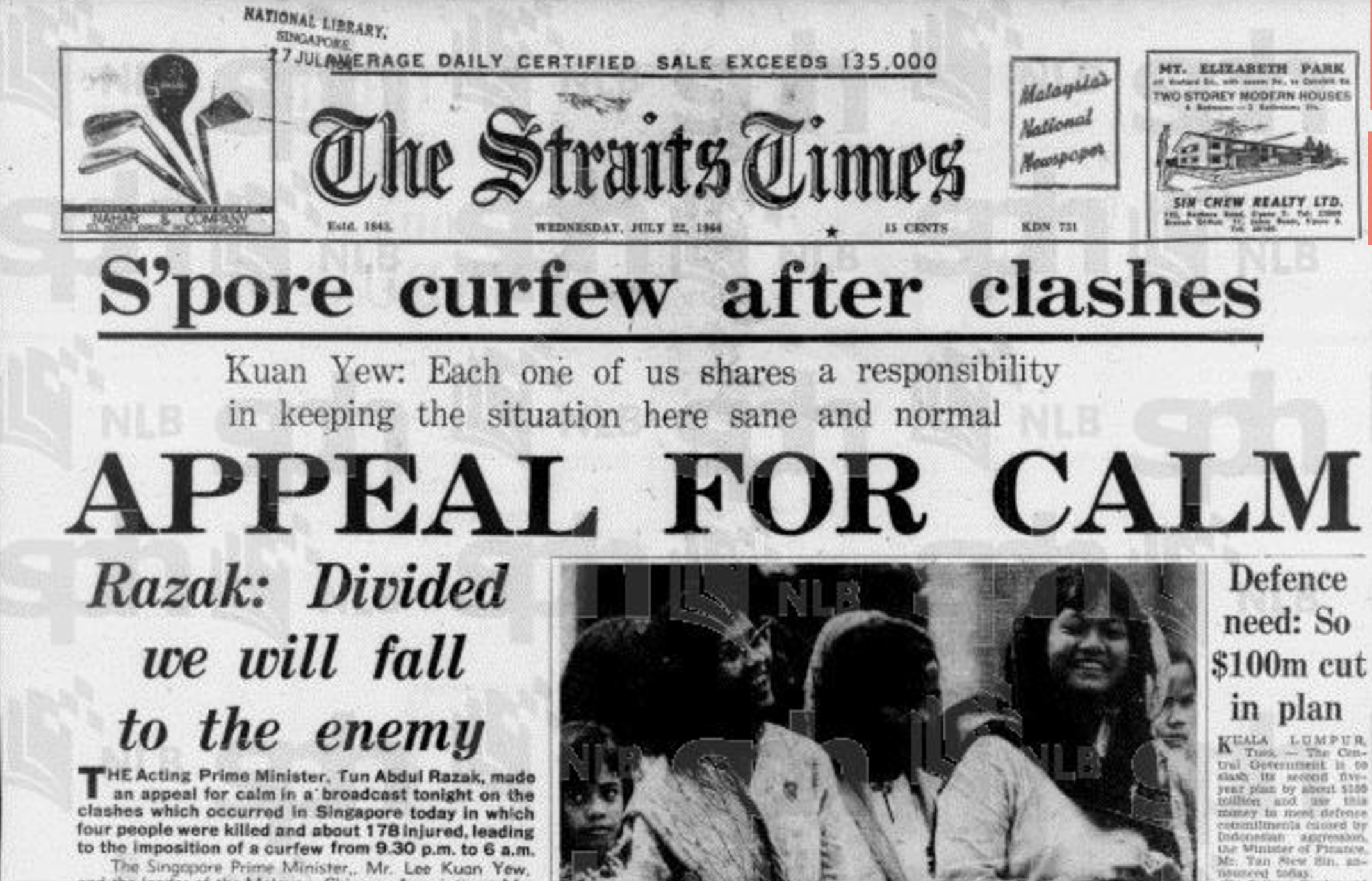Singapore's 1964 racial riots brought about a devastation that has been ingrained in the national consciousness.
The 1964 riots refer to two separate riots that broke out on July 21 and September 2, 1964. The riots had erupted as a result of political tensions built up between Singapore's PAP government and Malaysia's UMNO-led Alliance government.
Singapore was part of the Federation of Malaysia then, and some Malaysian politicians, such as Syed Jaafar Albar, had stirred up racial sentiments among Singapore's population, which led to the riots.
The riots also occurred against the backdrop of the Indonesia-Malaysia Confrontation, where Indonesia opposed the formation of Malaysia.
Here is a collection of stories which aim to bring you through the different perspectives of the people on the ground experiencing the riots in 1964.
The names are fictitious but the stories are based on actual facts.
Sep. 16, 1963
City Hall: Singapore joins the Federation of Malaysia
 Celebration of Malaysia Day at City Hall on Sept 16, 1963.
Celebration of Malaysia Day at City Hall on Sept 16, 1963.
The marching band's energetic melodies pulsed alongside the fervour that ran the length of City Hall.
A giant banner flashed the words MAJULAH MALAYSIA, as the crowd roared with the sweet promise of freedom.
After British rule and the dark era of the Japanese Occupation (1942 to 1945), Lim Boon Teck was certain that Singapore's entry into the Federation is finally the proverbial light at the end of the tunnel.
The lead up to this fateful union was not without bumps. Lim knew that Indonesia vehemently opposed the formation of the Federation of Malaysia, claiming that the federation was just a proxy for the British to continue exerting influence in the region.
Last week, Lim's cousin sent word back that Indonesian men were inflicting damage on their poultry farm in Sabah. He shuddered to think what would happen now that the Federation was a done deal.
***
While the skies over the Padang burned with the splendour of fireworks, Hassan Prakoso and his men quietly disembarked from their boat at Tanjong Rhu.
Their mission was simple: Deliver pamphlets and explosives to the Indonesian Consulate and the Bawean Association of Singapore and return to Riau - no questions asked.
Hassan shivered as the celebrations raged in town. From afar, the fervour of the crowd sounded like the roar of a tsunami.
Nine days later, the waves of the unification finally crashed ashore. In a fiery rhetoric, Indonesian President Sukarno vowed to ganyang (crush) Malaysia.
Dec. 11, 1963
Changi Beach: Singapore Special Branch Mission
Officer Abdul Halim stared at the pamphlet in his hands. His team had raided a fisherman's hut based on a tip-off and found stacks of Confrontation propaganda pamphlets like this one, calling for Malays to take back what is rightfully theirs from the Chinese.
"Abdul! Come see!" a voice called from outside the hut. He stuffed the pamphlet into his pocket and hurried outside. His colleague Hock Seng was standing beside a half opened crate. Peering inside, Abdul's face turned grim.
There were enough explosives inside to take down a building.
Jul. 12 1964
New Star Cinema, Pasir Panjang: SUMNO convention
Officer Abdul Halim could feel a heaving tension in the air. Earlier, the door to the theatre was shattered by the frenzied crowd when they rushed in.
Abdul shifted uneasily in the shadows. The convention was organised by SUMNO, the Singapore branch of the United Malays National Organisation (SUMNO), with local Malay groups to discuss the need for special rights for the Malays in Singapore.
Special Branch had sent him to Pasir Panjang to observe the convention undercover, and it seemed like it was off to a bad start.
Feeding off the pulsing energy of the audience, keynote speaker Syed Jaafar Albar from Malaysia's UMNO, started his rhetoric questioning the need to resettle Malay families from Kallang from a while back.
"Why Malay families? Is it because we are less important than Chinese families?" he asked in Malay, provoking jeers from the crowd.
The Kallang resettlement project had displaced a number of locals. Malay families only made up 10% of the displaced population, but the crowd wasn't told of this.
Syed Jaafar Albar worked the crowd into a frenzy by lashing out at the People's Action Party (PAP) for not doing more for the Malay community. He singled out PAP's Othman Wok, who was Singapore's Minister for Social Affairs then, labelling him a traitor who turned his back on his Malay community.
"Kill the traitor!" an angry voice called out from the crowd. Soon, the crowd was heaving as one, calling for the death of Othman Wok and Lee Kuan Yew.
***
One week later, Prime Minister Lee Kuan Yew, in a meeting with local Malay leaders declared that the PAP will not give Malays special treatment like how it had been done in Malaysia.
The next day, the UMNO controlled newspaper Utusan Melayu denounced Othman Wok as a traitor to the Malay community.
Jul. 21, 1964
Kampong Soo Poo
Even though the procession marking Prophet Muhammad's birthday was still a distance away, Utusan Melayu junior reporter Nadia Zainal could hear the festive cheers from where she stood at Kampong Soo Poo.
Based on a tip-off, her editor had instructed her to station herself at Kallang to catch "something interesting". When pressed for more information, the informant refused to say more.
Soon the procession entered the Kampong Soo Poo area. The contingents were singing songs and waving banners while little children ducked in and out of the parade shouting in glee. Nadia smiled at the kids.
Suddenly a bottle appeared in the air and landed on the head of an elderly lady in the parade. Without warning, the crowd erupted into a frenzy as stones flew and wounds split. Nadia froze as the parade contingents heaved in a mass of confusion before her eyes. Scanning the crowd, she spotted an elderly man with a maimed leg trying to drag himself out of the melee.
 Image via.
Image via.
[related_story]
Nadia dropped her bag and ran towards him, but before she could move any closer, Nadia felt a fist collide into the side of her head before she blacked out.
***
Across the island, clashes broke out as news of communal violence spread. At the end of the day, 4 deaths and 178 injuries were reported.
 Via NewspaperSG
Via NewspaperSG
The government imposed a curfew for the rest of July. However, it did not fully prevent violence. By the end of July, there were 23 deaths and 454 injuries.
A second round of rioting occured in September when a Malay trishaw rider was killed in Geylang Serai, sparking fresh violence between the Malays and Chinese communities. It resulted in another 13 deaths and 106 injuries.
Aftermath
After the first riots, on Aug. 23, 1964, Prime Minister Lee Kuan Yew blamed the Indonesians, communists, and Malay extremists in UMNO (known as UMNO Ultras) for causing the riots, pointing out that they had the common goal of destabilising Singapore.
After Singapore separated from the Federation of Malaysia in 1965, Lee was more vocal in blaming UMNO Ultras, especially Syed Jaafar Albar for misleading and stoking up the passion of local Malays. He also blasted the Utusan Melayu, a mouthpiece for UMNO, for inciting anger among its Malay readers.
Diplomatic cables from Australia and America also revealed an outsider's observation of the riots. Their reports also pointed at UMNO, as well as Indonesian psychological warfare for provoking local Malays, causing an atmosphere of heightened communal tensions during the procession.
In 1997, after years of healing and nation-building, Singapore designated July 21 as Racial Harmony Day, as a reminder to Singaporeans to treasure and uphold our multi-racial peace and unity.
Top image via NewspaperSG and here.
1819 is a labour of love by Mothership.sg where we tell stories from Singapore’s history, heritage & culture. Follow us on Facebook, Instagram and Twitter!
[related_story]
If you like what you read, follow us on Facebook, Instagram, Twitter and Telegram to get the latest updates.
